check engine light CHEVROLET CAMARO 1994 4.G User Guide
[x] Cancel search | Manufacturer: CHEVROLET, Model Year: 1994, Model line: CAMARO, Model: CHEVROLET CAMARO 1994 4.GPages: 292, PDF Size: 15.35 MB
Page 134 of 292
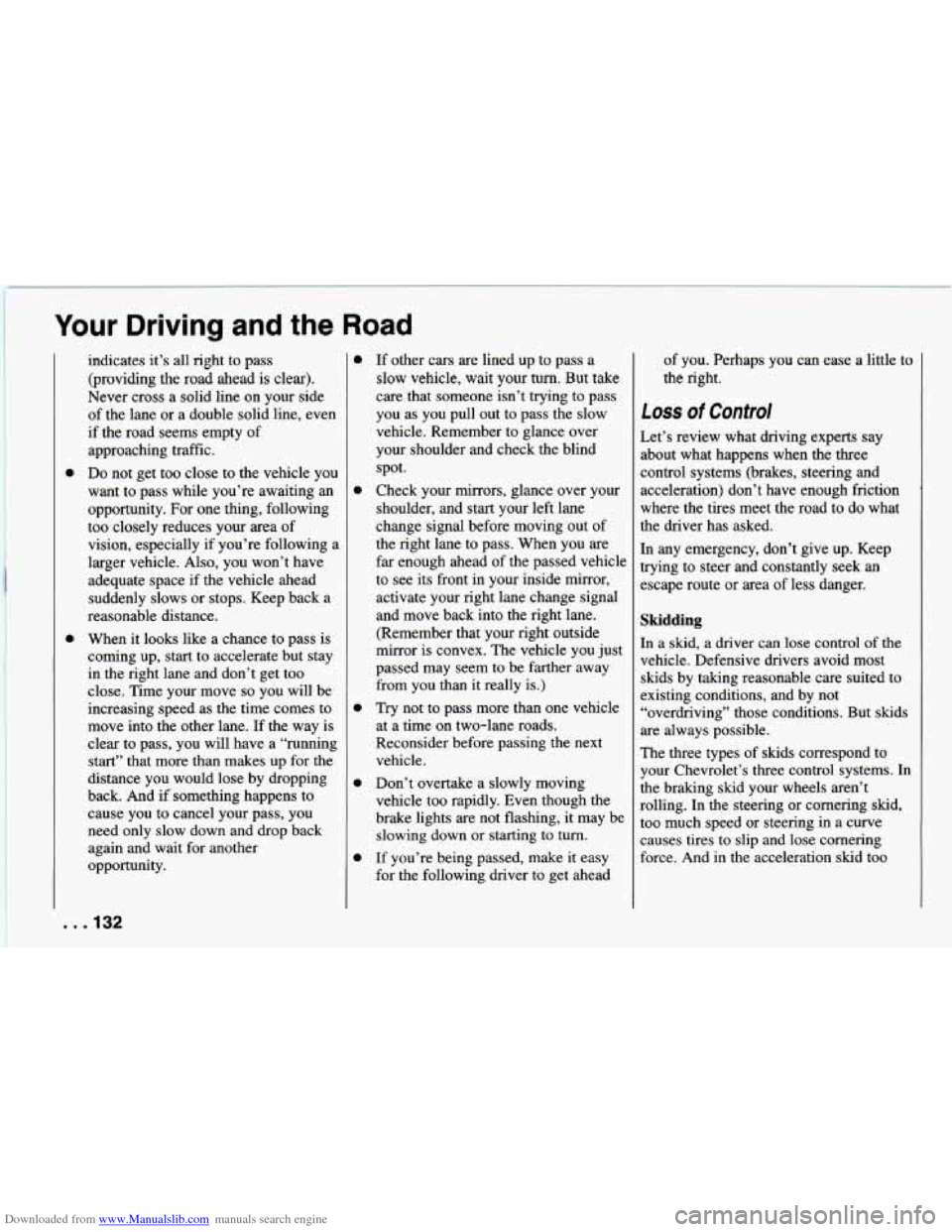
Downloaded from www.Manualslib.com manuals search engine Your Driving and the Road
a
a
indicates it’s all right to pass
(providing the road ahead is clear).
Never cross a solid line on your side
of the lane or a double solid line, even
if the road seems empty of
approaching traffic.
Do not get too close to the vehicle you
want to pass while you’re awaiting an
opportunity. For one thing, following
too closely reduces your area of
vision, especially if you’re following a
larger vehicle. Also, you won’t have
adequate space if the vehicle ahead
suddenly slows or stops. Keep back a
reasonable distance.
When it looks like a chance to pass is
coming up, start to accelerate but stay
in the right lane and don’t get too
close. Time your move
so you will be
increasing speed as the time comes to
move into the other lane. If the way is
clear to pass, you will have a “running
start” that more than makes up for the
distance you would lose by dropping
back. And
if something happens to
cause you to cancel your pass, you
need only slow down and drop back
again and wait for another
opportunity.
0
a
a
a
If other cars are lined up to pass a
slow vehicle, wait
your turn. But take
care that someone isn’t trying to pass
you as you pull out to pass the slow
vehicle. Remember to glance over
your shoulder and check the blind
spot.
Check your mirrors, glance over your
shoulder, and start your left lane
change signal before moving out of
the right lane to pass. When you are
far enough ahead of the passed vehicle
to see its front in your inside mirror,
activate your right lane change signal
and move back into the right lane.
(Remember that your right outside
mirror is convex. The vehicle you just
passed may seem to be farther away
from you than it really is.)
Try not to pass more than one vehicle
at a time on two-lane roads.
Reconsider before passing the next
vehicle.
Don’t overtake a slowly moving
vehicle too rapidly. Even though the
brake lights are not flashing, it may be
slowing down
or starting to turn.
If you’re being passed, make it easy
for the following driver to get ahead
of you. Perhaps you can ease a little to
the right.
loss of Control
Let’s review what driving experts say
about what happens when the three
control systems (brakes, steering and
acceleration) don’t have enough friction
where the tires meet the road to do what
the driver has asked.
In any emergency, don’t give up. Keep
trying to steer and constantly seek an
escape route or area of less danger.
Skidding
In a skid, a driver can lose control of the
vehicle. Defensive drivers avoid most
skids by taking reasonable care suited to
existing conditions, and by not
“overdriving” those conditions. But skids
are always possible.
The three types of skids correspond to
your Chevrolet’s three control systems. In
the brakmg skid your wheels aren’t
rolling. In the steering or cornering skid,
too much speed or steering in a curve
causes tires to slip and lose cornering
force. And in the acceleration skid too
. . .132
Page 136 of 292
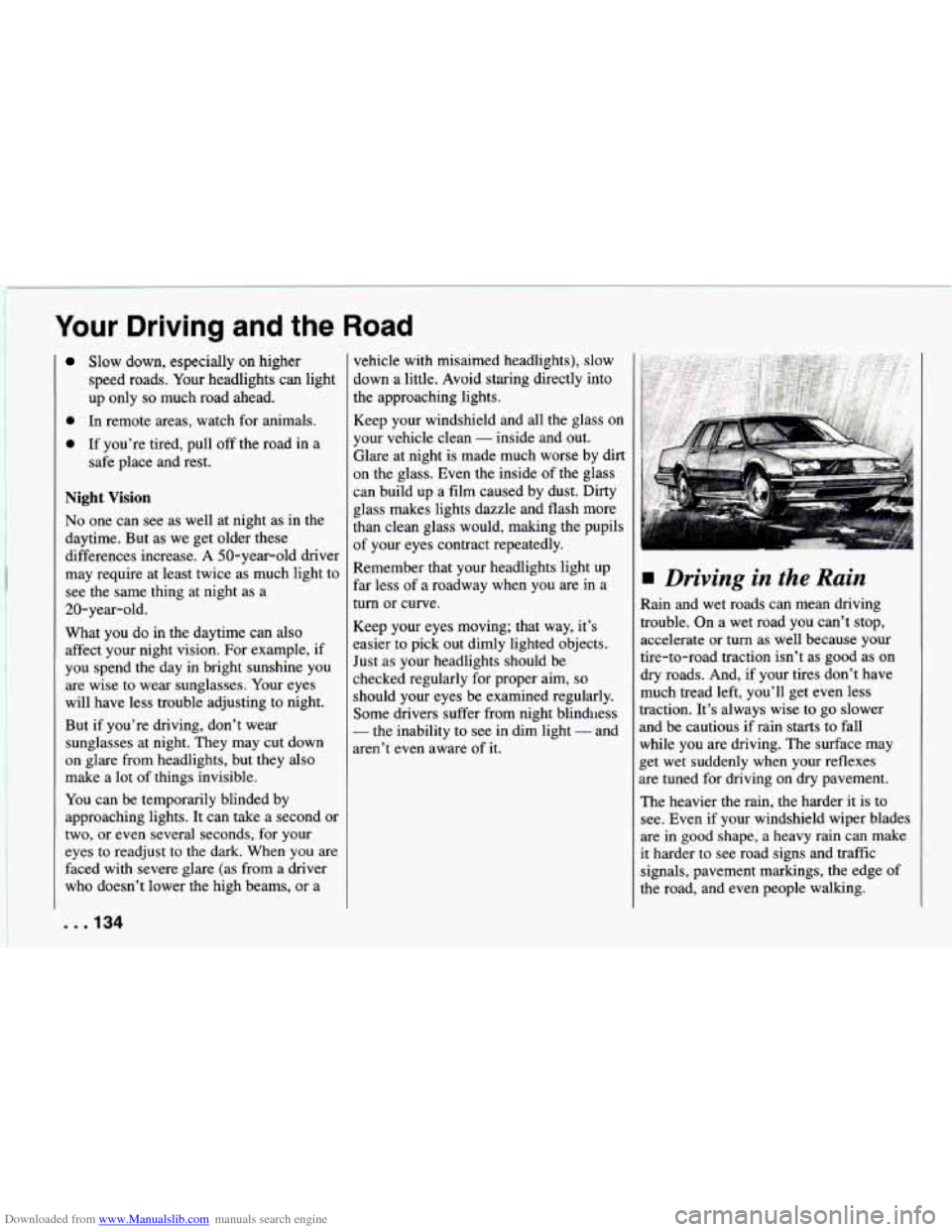
Downloaded from www.Manualslib.com manuals search engine Your Driving and the Road
Slow down, especially on higher
speed roads. Your headlights
can light
up only
so much road ahead.
0 In remote areas, watch for animals.
0 If you’re tired, pull off the road in a
safe place and rest.
Night Vision
No one can see as well at night as in the
daytime. But as we get older these
differences increase. A 50-year-old driver
may require at least twice as much light to
see the same thing at night as a
20-year-old.
What you do in the daytime can also
affect your night vision. For example, if
you spend the day in bright sunshine you
are wise to wear sunglasses. Your eyes
will have less trouble adjusting to night.
But if you’re driving, don’t wear
sunglasses at night. They may cut down
on glare from headlights, but they also
make a lot of things invisible.
You can be temporarily blinded by
approaching lights.
It can take a second or
two, or even several seconds, for your
eyes to readjust to the dark. When you are
faced with severe glare (as from a driver
who doesn’t lower the high beams, or a vehicle
with misaimed headlights), slow
down
a little. Avoid staring directly into
the approaching lights.
Keep your windshield and all the glass on
your vehicle clean
- inside and out.
Glare at night is made much worse by dirt
on the glass. Even the inside of the glass
can build up a film caused by dust. Dirty
glass makes lights dazzle and flash more
than clean glass would, malung the pupils
of your eyes contract repeatedly.
Remember that your headlights light up
far less of a roadway when you are in a
turn or curve.
Keep your eyes moving; that way, it’s
easier to pick out dimly lighted objects.
Just as your headlights should be
checked regularly for proper aim,
so
should your eyes be examined regularly.
Some drivers suffer from night blinduess
- the inability to see in dim light - and
aren’t even aware of
it.
Driving in the Rain
Rain and wet roads can mean driving
trouble. On a wet road you can’t stop,
accelerate or turn as well because your
tire-to-road traction isn’t as good as on
dry roads. And, if your tires don’t have
much tread left, you’ll get even less
traction. It’s always wise
to go slower
and be cautious if rain starts to fall
while you are driving. The surface may
get wet suddenly when your reflexes
are tuned for driving on dry pavement.
The heavier the rain, the harder it is to
see. Even if your windshield wiper blades
are in good shape, a heavy rain can make
it harder to see road signs and traffic
signals, pavement markings, the edge of
the road, and even people walking.
. . .I34
Page 138 of 292

Downloaded from www.Manualslib.com manuals search engine Your Driving and the Road
Hydroplaning usually happens at higher
speeds. There just isn’t
a hard and fast
rule about hydroplaning. The best advice
is to slow down when it is raining.
Some Other Rainy Weather Tips
0
0
0
Turn on your low-beam headlights -
not just your parking lights - to help
make you more visible to others.
Besides slowing down, allow some
extra following distance. And be
especially careful
when you pass
another vehicle. Allow yourself more
clear room ahead, and be prepared to
have your view restricted by road
spray.
Have good tires with proper tread
depth. (See “Tires”
in the Index.)
City Driving
One of the biggest problems with city
streets is the amount
of traffic on them.
You’ll want to watch out for what the
other drivers are doing and pay attention
to traffic signals.
Here are ways to increase your safety
in
city driving:
Know the best way to get to where
you are going.
Get a city map and plan
your trip into an unknown part of the
city just as you would for a
cross-country trip.
Try to use the freeways that rim and
crisscross most large cities. You’ll
save time and energy. (See the next
section, “Freeway Driving.”)
Treat a green light as a warning signal.
A traffic light
is there because the
corner
is busy enough to need it.
When a light turns green, and just
before you start to move, check both
ways for vehicles that have not
cleared the intersection or may be
running the red light.
. . .136
Page 139 of 292

Downloaded from www.Manualslib.com manuals search engine Freeway Driving
Mile for mile, freeways (also called
thruways, parkways, expressways, turnpikes, or superhighways) are the
safest of all roads. But
they have their
own special rules.
The most important advice
on freeway
driving is: Keep up with traffic and keep
to the right. Drive at the same speed most
of the other drivers are driving. Too-fast
or too-slow driving breaks a smooth
traffic flow. Treat the left lane
on a
freeway as a passing lane.
At the entrance there is usually a ramp
that leads
to the freeway. If you have a
clear view of
tHe freeway as you drive
along the entrdnce ramp, you should 3egin
to check traffic. Try to determine
where
you expect to blend with the flow.
Try to merge into the gap at close to the
prevailing speed. Switch on your
turn
signal, check your mirrors and glance
wer your shoulder
as often as necessary.
Iiy to blend smoothly with the traffic
flow.
Once you are
on the freeway, adjust
your speed to the posted limit or
to the
prevailing rate
if it’s slower. Stay in the
right lane unless you want to pass.
Before changing lanes, check your
mirrors. Then use your turn signal.
Just before you leave the lane, glance
quickly over your shoulder to make sure
there isn’t another vehicle in your “blind”
spot.
Once you are moving on the freeway,
make certain you allow a reasonable
following distance. Expect to move
slightly slower at night.
When
you want to leave the freeway,
move to the proper lane well in advance.
If you miss your exit do
not, under any
circumstances, stop and back up. Drive
on
to the next exit. The
exit ramp can be curved, sometimes
luite sharply. The exit speed is usually
losted. Reduce your speed according to
lour speedometer, not to your sense
of
notion. After driving for any distance at
ligher speeds,
you may tend to think you
we going slower than
you actually are.
Before Leaving on a Long Trip
Make sure you’re i-eady. Try to be well
hted.
If you must start when you’re not
iresh
- such as after a day’s work -
jon’t plan to make too many miles that
first part of the journey. Wear comfortable
zlothing and shoes you can easily drive
Ln.
[s your vehicle ready for a long trip? If
yob keep it serviced and maintained, it’s
ready to
go. If it needs service, have it
done before starting out. Of course, you’ll
find experienced and able service experts
in Chevrolet dealerships all across North
America. They’ll be ready and willing to
help if you need it.
Here are some things you can check
before a trip:
0 Windshield Washer Fluid: Is the
reservoir full? Are all windows clean
inside and outside?
Page 140 of 292
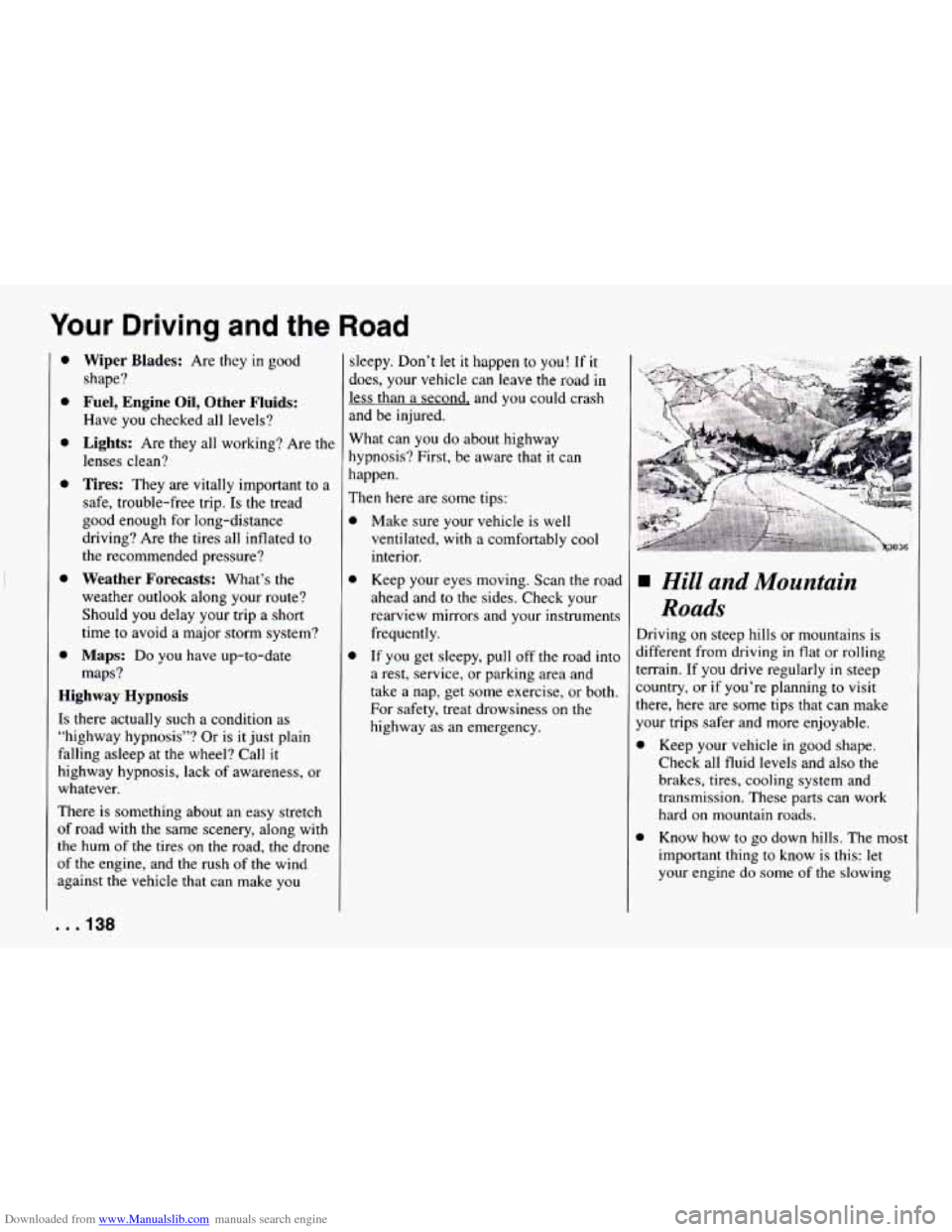
Downloaded from www.Manualslib.com manuals search engine Your Driving and the Road
e
e
Wiper Blades: Are they in good
shape?
Fuel, Engine Oil, Other Fluids:
Have you checked all levels?
Lights: Are they all working? Are the
lenses clean?
Tires: They are vitally important to a
safe, trouble-free trip. Is the tread
good enough for long-distance
driving? Are the tires all inflated to
the recommended pressure?
Weather Forecasts: What’s the
weather outlook along your route?
Should you delay your trip a short
time to avoid a major
storm system?
Maps: Do you have up-to-date
maps?
Highway Hypnosis
Is there actually such a condition as
“highway hypnosis”? Or is it just plain
falling asleep at the wheel? Call
it
highway hypnosis, lack of awareness, or
whatever.
There is something about an easy stretch
of road with the same scenery, along with
the hum of the tires
on the road, the drone
of the engine, and the rush
of the wind
against the vehicle that can make you sleepy. Don’t
let it happen to
you! If it
does, your vehicle can leave the road in
less than a second, and you could crash
and be injured.
What can you do about highway
hypnosis? First, be aware that
it can
happen.
Then here are some tips:
Make sure your vehicle is well
ventilated,
with a comfortably cool
interior.
Keep your eyes moving. Scan the road
ahead and
to the sides. Check your
rearview mirrors and your instruments
frequently.
If you get sleepy, pull
off the road into
a rest, service, or parking area and
take
a nap, get some exercise, or both.
For safety, treat drowsiness on the
highway as an emergency.
Hill and Mountain
Roads
Driving on steep hills or mountains is
different from driving
in flat or rolling
terrain.
If you drive regularly in steep
:ountry, or
if you’re planning to visit
there, here are some tips that can make
your trips safer and more enjoyable.
Keep your vehicle
in good shape.
Check all fluid levels and also the
brakes, tires, cooling system and
transmission. These parts can work
hard on mountain roads.
Know how to go down hills. The most
important thing
to know is this: let
your engine do some of the slowing
. . .13%
Page 147 of 292
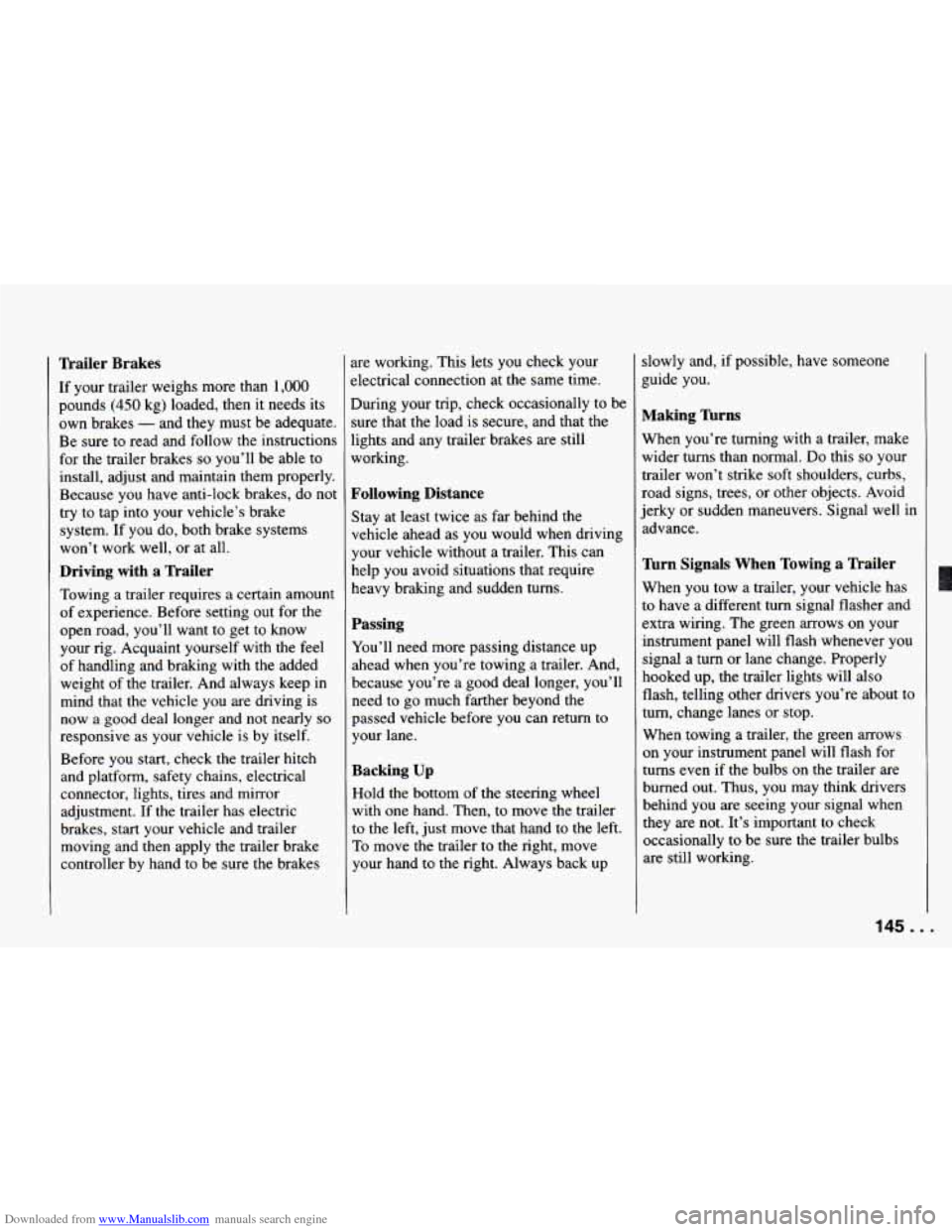
Downloaded from www.Manualslib.com manuals search engine Trailer Brakes
If your trailer weighs more than 1,000
pounds (450 kg) loaded, then it needs its
own brakes
- and they must be adequate.
Be sure to read and follow the instructions
for the trailer brakes
so you’ll be able to
install, adjust and maintain them properly.
Because you have anti-lock brakes, do not
try to tap into your vehicle’s brake
system. If you do, both brake systems
won’t work well, or at all.
Driving with a Trailer
Towing a trailer requires a certain amount
of experience. Before setting out for the
open road, you’ll want to get to know
your rig. Acquaint yourself with the feel
of handling and braking with the added
weight of the trailer. And always keep in
mind that the vehicle you are driving is
now
a good deal longer and not nearly so
responsive as your vehicle is by itself.
Before you start, check the trailer hitch
and platform, safety chains, electrical
connector, lights, tires and mirror
adjustment. If the trailer has electric
brakes, start your vehicle and trailer
moving and then apply the trailer brake
controller by hand to be sure
the brakes are working.
This lets
you check your
electrical connection at the same time.
During your trip, check occasionally to be sure that the load is secure, and that
the
lights and any trailer brakes are still
working.
Following Distance
Stay at least twice as far behind the
vehicle ahead as you would when driving
your vehicle without a trailer. This can
help you avoid situations that require
heavy braking and sudden turns.
Passing
You’ll need more passing distance up
ahead when you’re towing a trailer. And,
because you’re a good deal longer, you’ll need to go much farther beyond the
passed vehicle before you can return
to
your lane.
Backing Up
Hold the bottom of the steering wheel
with one hand. Then, to move the trailer
to the left, just move that hand to the left.
To move the trailer to the right, move
your hand to the right. Always back up slowly
and, if possible, have someone
guide you.
Making Turns
When you’re turning with a trailer, make
wider turns than normal.
Do this so your
trailer won’t strike soft shoulders, curbs,
road signs, trees, or other objects. Avoid
jerky or sudden maneuvers. Signal well in
advance.
Turn Signals When Towing a Trailer
When you tow a trailer, your vehicle has
to have a different turn signal flasher and
extra wiring. The green arrows on your
instrument panel will flash whenever you
signal a turn or lane change. Properly
hooked up, the trailer lights will also
flash, telling other drivers you’re about to
turn, change lanes or stop.
When towing a trailer, the green arrows
Dn your instrument panel will flash for
turns even if the bulbs on the trailer are
burned out. Thus, you may think drivers
behind you
are seeing your signal when
they are not. It’s important to check
occasionally to be sure the trailer bulbs
are still working.
145. I
Page 151 of 292

Downloaded from www.Manualslib.com manuals search engine Jump Starting
If your battery has run down, you may
want to use another vehicle and some
jumper cables to start your Chevrolet. But
please follow the steps below to do it
safely. NOTICE:
Ignoring these steps could result in
costly damage to your vehicle that
wouldn’t be covered by your war-
ranty.
Trying to start your Chevrolet by
pushing or pulling
it could damage
your vehicle, even
if you have a
manual transmission. And if you
have an automatic transmission,
it
won’t start that way.
To Jump Start Your Chevrolet:
1. Check the other vehicle. It must have
a 12-volt battery with a negative
ground system.
NOTICE:
If the other system isn’t a 12-volt
system with a negative ground, both
vehicles can be damaged.
2. Get the vehicles close enough so the
jumper cables can reach, but be sure
the vehicles aren’t touching each other.
If they are,
it could cause a
ground connection you don’t want.
You wouldn’t be able to start your
Chevrolet, and the bad grounding
could damage the electrical systems.
3. Turn off the ignition on both vehicles.
Turn off all lights that aren’t needed,
and radios. This
will avoid sparks and
help save both batteries. And
it could
save your radio!
NOTICE:
If you leave your radio on, it could be’
badly damaged. The repairs wouldn’t
be covered
by your warranty.
4. Open the hoods and locate the
batteries.
149 ...
Page 189 of 292

Downloaded from www.Manualslib.com manuals search engine LOW OIL
Engine Oil
If the “LOW OIL” light on the instrument
panel comes on,
it means you need to
check your engine oil level right away.
For more information, see “Low Oil
Light” in the Index. You should check
your engine oil level regularly; this
is an
added reminder.
3.4L L32 (Code S)
It’s a good idea to check your engine oil
every time you get fuel. In order to get an
accurate reading, the oil must be warm
and the vehicle must be
on level ground.
5.7L LTl (Code P)
rurn off the engine and give the oil a few
ninutes to drain
back into the oil pan. If
rrou don’t, the
oil dipstick might not show
he actual level.
187 ...
Page 190 of 292
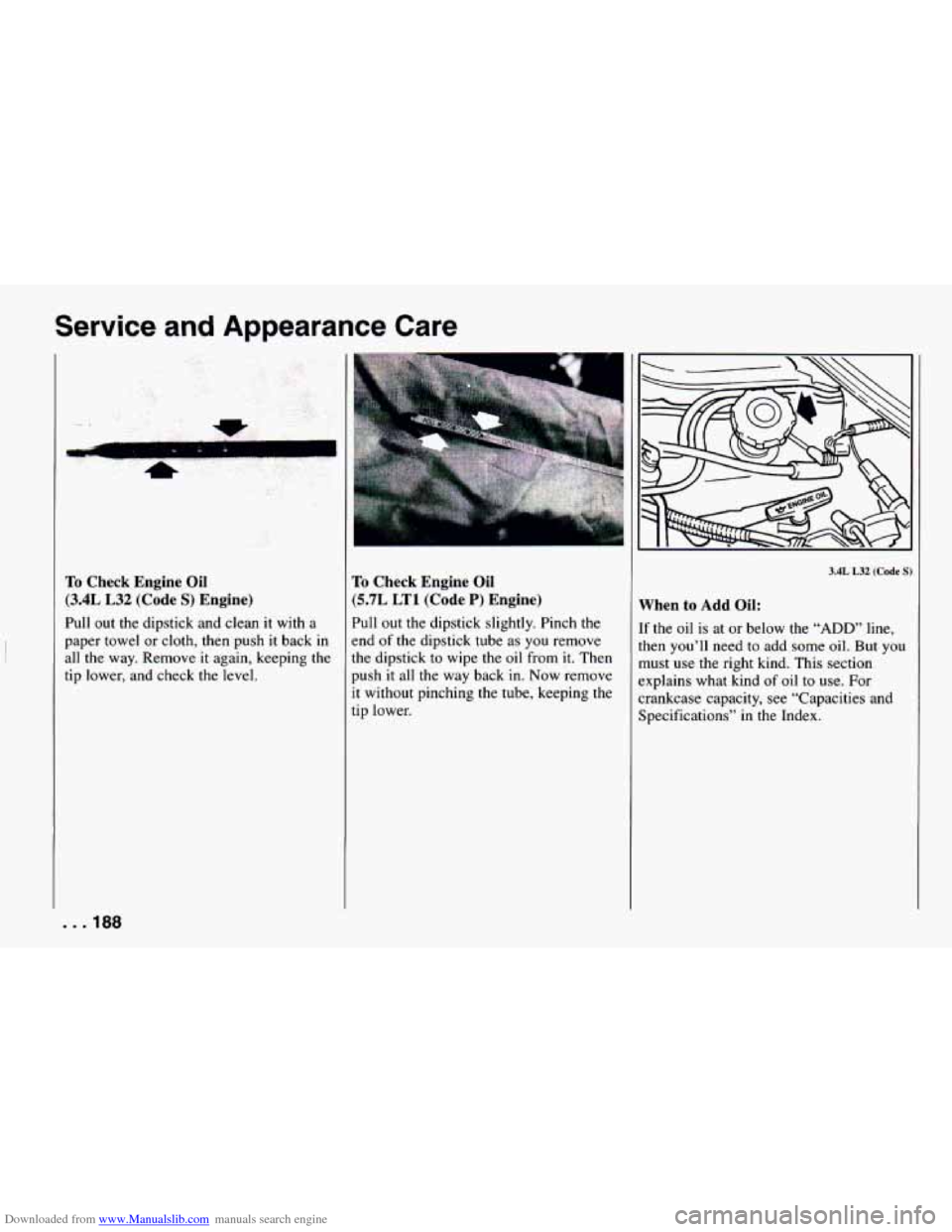
Downloaded from www.Manualslib.com manuals search engine Service and Appearance Care
”,
d
4
To Check Engine Oil
(3.4L L32 (Code S) Engine)
Pull out the dipstick and clean it with a
paper towel or cloth, then push it back in
all the way. Remove it again, keeping the
tip lower, and check the level.
IC
To Check Engine Oil
(5.7L LTl (Code P) Engine)
Pull out the dipstick slightly. Pinch the
end
of the dipstick tube as you remove
the dipstick to wipe the oil from it. Then
push it all the way back in. Now remove
it without pinching the tube, keeping the
tip lower.
3.4L L32 (Code S)
When to Add Oil:
f the oil is at or below the “ADD” line,
hen you’ll need to add some oil. But you
nust use the right kind. This section
:xplains what kind
of oil to use. For
:rankcase capacity, see “Capacities and
ipecifications” in the Index.
. . .I88
Page 201 of 292
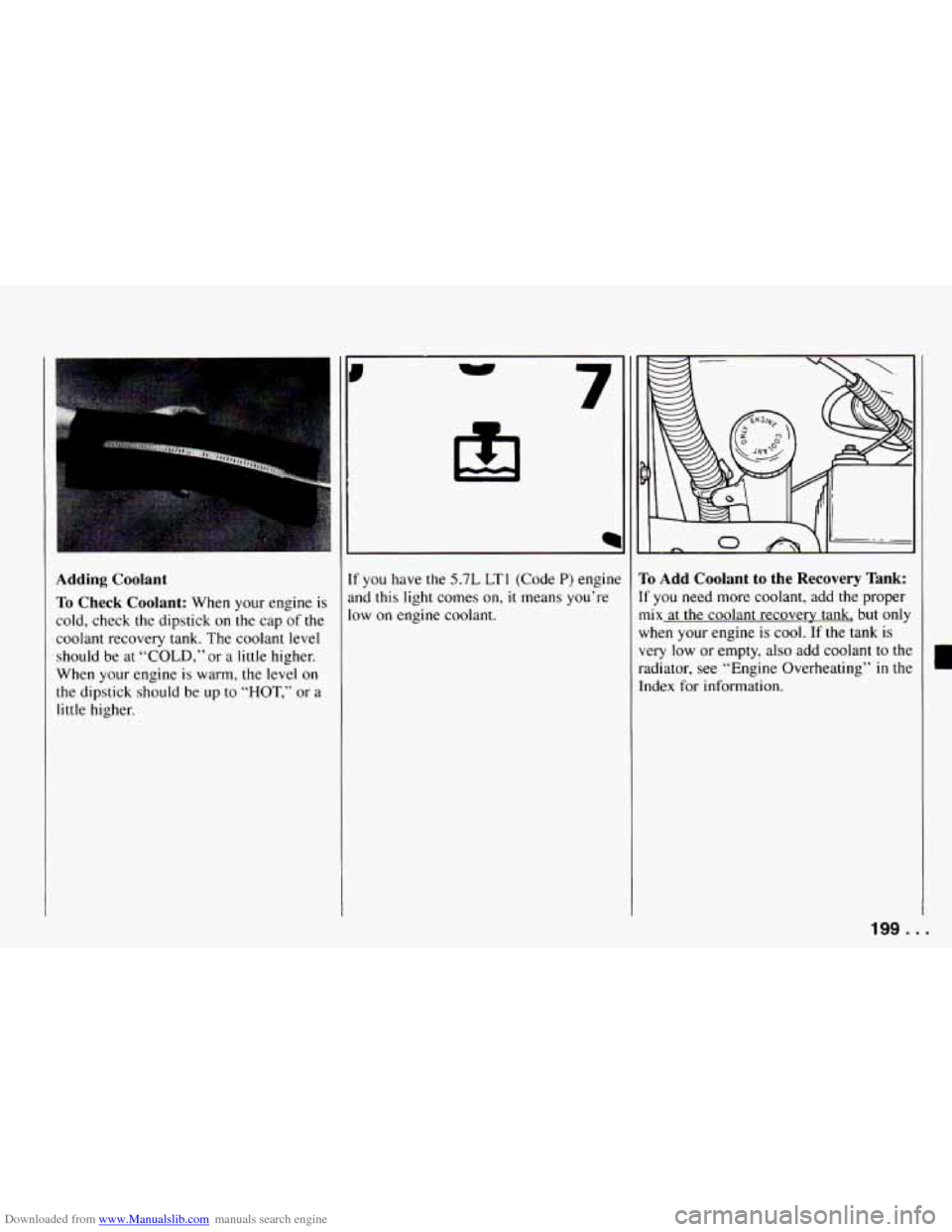
Downloaded from www.Manualslib.com manuals search engine Adding Coolant
To Check Coolant:
When your engine is
cold, check the dipstick on the cap of the
coolant recovery tank. The coolant level
should be at
“COLD,” or a little higher.
When your engine
is warm, the level on
the dipstick should be up to
“HOT,” or a
little higher.
If you have the 5.7L LTI (Code P) engine
and this light comes on,
it means you’re
low on engine coolant.
To Add Coolant to the Recovery Tank:
If you need more coolant, add the proper
mix at the coolant recovery tank, but only
when your engine
is cool. If the tank is
very low or empty, also add coolant to the
radiator, see “Engine Overheating” in the
Index for information.
199 ...